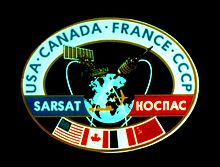International Cospas-Sarsat Programme
Distress alerts are detected, located and forwarded to over 200 countries and territories at no cost to beacon owners or the receiving government agencies.The term Cospas-Sarsat derives from COSPAS (КОСПАС), an acronym from the transliterated Russian "Космическая Система Поиска Аварийных Судов" (Latin script: "Cosmicheskaya Sistema Poiska Avariynyh Sudov"), meaning "Space System for the Search of Vessels in Distress", and SARSAT, an acronym for "Search And Rescue Satellite-Aided Tracking".(Some countries may impose licensing and/or registration charges for beacon ownership, and some jurisdictions may assess costs for rescue operations.A SARP instrument records the data from the distress signal so that the information can later be gathered by a ground station when the satellite passes overhead.The range and bearing are measured from the rate of change of the received frequency, which varies both according to the path of the satellite in space and the rotation of the Earth.MEOSAR consists of SARR transponders aboard the following navigation-satellite constellations: the European Union's Galileo, Russia's Glonass, and the United States' Global Positioning System (GPS).[18][19][20][21] In November 2022, China became the newest MEOSAR space-segment provider, with Cospas-Sarsat SAR payloads aboard six of its BeiDou (BDS) navigation spacecraft.Following continued testing and adjustment, a declaration of initial operational capability (IOC) was made by the Cospas-Sarsat Council effective from 25 April 2023.GPS Block IIIF satellites are planned to have dedicated, operational L-band SAR payloads provided by Canada, with launches beginning around 2026.Most commonly, Cospas-Sarsat beacons have a 121.5-MHz transmitter to provide a signal that can be received by local search crews (airborne, on ground or at sea) using direction-finding equipment.Additionally, the latest EPIRBs include an automatic identification system (AIS) transmitter in the marine VHF band that allows the beacon to be easily tracked from nearby vessels.Recent PLB models designed for attachment to marine life vests transmit an AIS signal to act as a maritime survivor locating system, also known as a man overboard (MOB) system, that activates alarms on nearby vessels and allows the beacon to be tracked by properly equipped vessels.In response to recent commercial aviation disasters and subsequent ICAO requirements for autonomous tracking of aircraft in distress,[31][32] Cospas-Sarsat established specifications for ELTs for distress tracking (ELT(DT)s) to meet the ICAO requirements (amended Annex 6, Part I of the Convention on International Civil Aviation).In this way, ELT(DT)s allow a plane in distress to be tracked in-flight, prior to any crash, without human intervention aboard the aircraft.Cospas-Sarsat capability for receiving and processing distress messages from ELT(DT)s using the narrowband BPSK transmission method was declared operational effective 1 January 2023.In October 2023 capability for receiving and processing distress messages from ELT(DT)s using the spread-spectrum QPSK modulation method was declared with an effective date of 1 January 2024.[33] Cospas-Sarsat has recently specified a new, additional beacon modulation and message scheme based on spread-spectrum technology with quadrature phase-shift keying (QPSK).While the satellite's operation was being verified on September 9, COSPAS-1 detected an ELT signal in British Columbia and relayed the information to a then-experimental ground station at Defence Research Establishment Ottawa (DREO).The Canadians calculated the position of the small aircraft, which was 90 km (56 mi) off course, and within hours the crash survivors were rescued via airlift.Typically PLBs are used by people engaged in recreational activities in remote areas, and by small-aircraft pilots and mariners as an adjunct to (or, when permitted, a substitute for) an ELT or EPIRB.Such beacons determine their location using the internal GNSS receiver (or a connection to an external navigation source) and transmit in their distress message highly accurate position reports.This two-tiered reliability and global coverage of the system has inspired the current motto of SAR agencies: "Taking the 'Search' out of Search and Rescue.



Intergovernmental organizationMontrealQuebecCanadaAlgeriaArgentinaAustraliaBrazilCyprusDenmarkFinlandFranceGermanyGreeceIndonesiaMalaysiaNetherlandsNew ZealandNigeriaNorwayPakistanPolandRussiaSaudi ArabiaSerbiaSingaporeSouth AfricaSwedenSwitzerlandThailandTunisiaTurkeyUnited Arab EmiratesUnited KingdomUnited StatesViet NamHong Kong, China, Marine DepartmentInternational Telecommunication Development Company (Taiwan)**European UnionEUMETSATEnglishFrenchRussianSecretariatsatellitesearch and rescuetreatynonprofitintergovernmentalhumanitarianemergency locator radio beaconssatellitestransponderssignal processorsDistress alertscountriesterritoriesSoviet UnionStatesacronymtransliteratedLatin scriptsearch-and-rescueDistress beaconsnational administrationsflight information regionUnited NationsInternational Civil Aviation OrganizationInternational Maritime OrganizationInternational Telecommunication UnionGlobal Maritime Distress Safety SystemEPIRBsInternational Convention for the Safety of Life at Seadigitalanalog signalSpace Foundationground segmentspace segmentDistress radio-beaconsdownlinkground stationsMission control centresrescue coordination centresdistress beaconlow-altitude Earth orbitgeostationary Earth orbitmedium-altitude Earth orbitsecondary payloadantennassatellite dishesphased antenna arraysalgorithmsbinary codedmeteorologicalnavigationfootprintstore-and-forwardreal-timeDopplerbearingalgorithmtrilaterateground trackfootprintsGalileoGlonassGlobal Positioning SystemBeiDouSAR-equipped BDS spacecraftEgyptAir flight 804S-bandGPS Block IIRGPS Block IIFGPS Block IIIAGPS Block IIIFL-banddistress radio-beaconautomatic identification systemmarine VHFConvention on International Civil Aviationmodulationphase-shift keyingnarrowbandbandwidthspread-spectrumCommunications Research Centre Canada